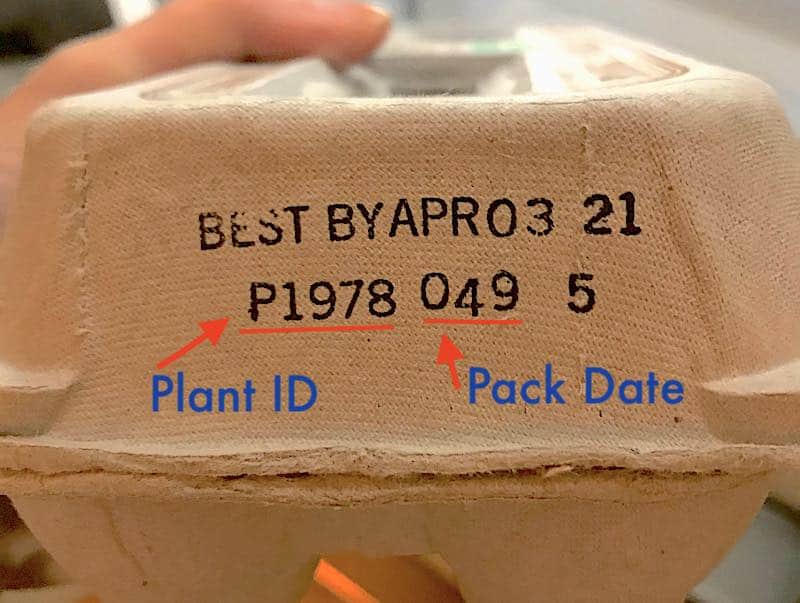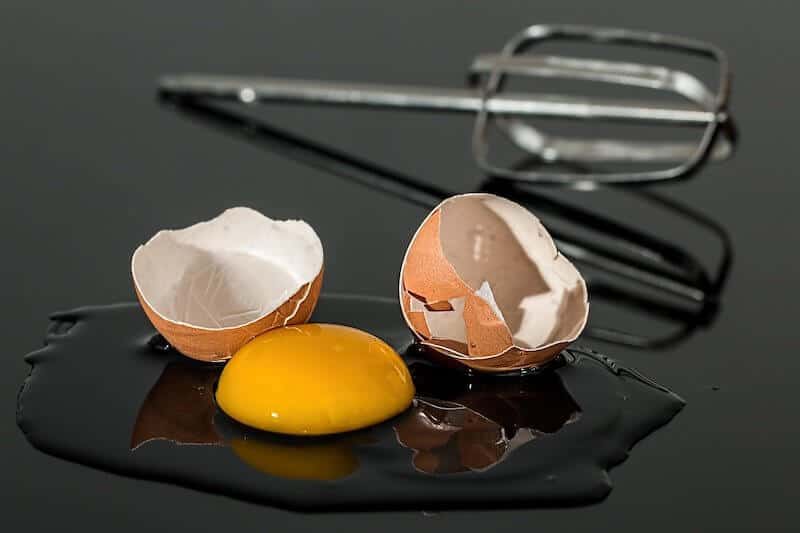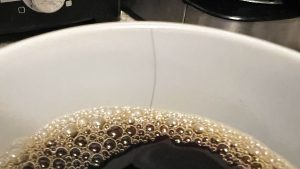This page may contain affiliate links. If you click and buy, we might get a small commission at no cost to you.
Eggs are a staple food in many households. They can be a quick source of protein and nutrients, or the glue that holds a recipe together. But sometimes after you crack an egg, something doesn’t look or smell quite right. Should you continue to use the egg? In this article we will look at how to tell if eggs are bad after cracking. We will also discuss what the dates mean on egg cartons and why eggs should be kept refrigerated.
How To Tell If Eggs Are Bad After Cracking
1. The Sniff Test
Sometimes, the nose knows best. A cracked egg shouldn’t have much of an odor at all. They should mostly smell neutral. If an egg has gone bad it often has a noticeably nasty odor that smells like sulfur. Like natural gas or an icky swamp.
What causes this sulfuric scent? Eggs are full of globulin and keratin, which are both proteins. When globulin decays it released hydrogen sulfide, a pungent sulfide gas. The protein keratin has high levels of the amino acid cysteine. Cysteine contains a lot of sulfur atoms, so when the keratin breaks down, cysteine is released and the sulfur atoms contribute to that rotten smell.
If you crack an egg and it has a distinctly bad scent, no matter what you think it smells like, toss it. A healthy raw egg shouldn’t smell.
What if an egg smells after cooking?
If you notice that sulfur-y smell after cooking eggs, not to worry. Egg whites, as we’ve said, contain sulfur compounds. Egg yolks contain iron. When you heat eggs, the sulfur compounds and iron can react with each other to produce that “rotten egg” smell. This is normal and doesn’t mean your eggs have gone bad. If the aroma is strong, it probably means you cooked your eggs at too high a temperature. At high temps, those sulfide compounds form rapidly.
2. Firmness
In a healthy, fresh egg, both the egg white and yolk will be slightly firm. Firm enough to appear almost like a gelatin that is able to hold its shape. The yolk will sit high and be nicely rounded. The whites will appear thick.
As an egg gets older, the stiffness of the whites and yolks declines. The yolk may look flatter and both can become runny. If you think your cracked eggs look a bit too runny, check the sell by and pack date on the carton.
Just because an egg has gotten a little old does not automatically mean it has gone bad. As long as the carton shows the eggs are still within a safe age window, and there is no smell or discoloration, they are probably still fine to eat. We will talk more about expiration dates below.
3. Discoloration
Bacterial growth within the egg can cause discoloration. Any unusual coloration such as pink, blue, black or green seen in either the yolk or the whites may indicate bacterial growth and the egg should probably be tossed. There are occasionally other factors that can change egg color without being harmful, but to be safe I would skip eating anything that wasn’t normally colored.
Fun fact, egg whites look cloudiest when fresh, and become clearer as they age. The cloudiness is caused by carbon dioxide that has not yet escaped through the shell. As time passes, more and more of the CO2 escapes through the shell and the whites appear clearer and clearer. So a cloudy egg white means it is quite fresh indeed!
What the “proper” color of egg yolks should be can vary a little, depending on the hens diet. If she was eating mainly yellow foods such as corn or wheat, her yolks could be yellow or slightly pale. But if she has eaten other plants with slightly darker pigments, her yolks could be a darker, orange-yellow. So if you happen to crack a batch of eggs and the yolks look darker or lighter than your last carton, that’s nothing to worry about.
Discoloration after cooking
If you are a hard boiled egg fan you may sometimes notice a dark, discolored ring has formed around the yolk after cooking. This is a reaction between the sulfur present in the egg whites and the iron present in the egg yolks.
It will typically occur if the eggs have been cooked at too high a temperature, or for too long. This is harmless and the eggs are still safe to eat. You can minimize this reaction by reducing your water temperature, and then coolings the eggs immediately post cooking.
Scrambled eggs too, can take on a green or grey coloration. These are still safe to eat, and the discoloration is caused by chemical reactions between the compounds in the egg or between the egg and the iron in the pan it was cooked in. If this happens often to you it may be the pan you are using, or experiment with the amount of heat and cook time you are using.
What about bloody eggs?
It can be unappetizing when you crack an egg and see a blood spot in the yolk. According to the USDA, this does not mean the egg unsafe to eat, as long as it is properly cooked. You can continue to cook with the egg as-is, or scrape off the spot with a knife before using the rest of the egg. It may be fine to eat, but I’m sure a lot of us would be just a little turned-off by the sight.
You may have heard that a blood spot indicates the yolk was fertilized or that it is part of a fetus. This is not true. Blood spots develop when a blood vessel in the hen’s ovaries or oviduct ruptures and bleeds a little during the formation of the egg. It is a natural process and doesn’t indicate a bad egg (or a sick hen).
Understanding Egg Expiration Dates
If you suspect something is off about your eggs, one way to help make the decision to keep or toss is checking the expiration date. However, there can be multiple dates and numbers on a carton, and understanding what they mean can help you to not throw out perfect good eggs.
Sell By Date: While not required, most cartons will list a sell by date. This date indicates how long the store should offer the eggs for sale. This date will typically be 20-30 days after the eggs were packed. If the eggs were packed in a USDA-inspected plant, the sell by date cannot exceed 30 days. That does not mean that on day 31, the eggs will be unsafe to eat. It is to make sure you have enough time to use your eggs after bringing them home.
Expiration Date: The expiration date or “best if used by” date typically will be listed as 30 days after the pack date and reflects the same information as the “sell by” date. But this can vary and lately I have seen “best by” dates that are around 44 days after the pack date.
Pack Date: If the eggs come from a USDA-inspected plant, then the carton will include a number between 001 and 365 that indicates the day of the year the eggs were graded and packed. In this numbering system, called the julian date, 001 is January 1st and 365 is December 31st. This is the clearest date to base your calculations off of, since things like “sell by” and “best by” can vary in meaning.
See the example below. The codes used and placement of the numbers may vary. However in general, there will be a P followed by a series of numbers, this is the ID of the plant where the packing took place. There will either be a separate grouping of three digits to indicate the pack date, or if all the numbers run together it will typically be the last three digits in the string.

If eggs are properly refrigerated, they will remain fresh for up to 50 days after packing. That means 6-7 weeks after the pack date, or about 2-3 weeks after the “sell by” date. If you want to keep them that long, it’s up to you. Sometimes eggs that have aged to 6-7 weeks will not perform as well in recipes as fresher, “younger” eggs.
Proper Refrigeration for Eggs
A key to keeping eggs fresh and avoiding spoilage before you eat them is proper refrigeration. The Food and Drug Administration requires that eggs sold commercially be transported and stored below 45°F.
Once refrigerated, they must be continually stay refrigerated. Refrigeration slows down potential for bacteria to grow inside the egg. But also, if an egg warms up too much after having been refrigerated, condensation will form on the shell. Any water or moisture on the egg can potentially allow bacteria to penetrate the shell.
This is because in the U.S., eggs are sterilized before they are sold. They are washed in hot water and sprayed with a disinfectant. This kills bacteria such as Salmonella found on the eggshell. Cleansing the egg like this, however, often removes or weakens the eggs protective coating call the cuticle. With the cuticle gone, it is easier for bacteria to penetrate the eggshell. Thus, the egg must be kept refrigerated after this process.
In some countries eggs are not washed in this manner. They control Salmonella by vaccinating the laying hens and keeping higher levels of sanitation at the farm. Therefore these eggs have their cuticle in-tact to help prevent against bacteria, and the eggs are not kept refrigerated. However they do have a shorter shelf-life.



